Assessment of quality and shelf-life of salt-smoked cured products from Pangasius catfish at various temperatures
Abstract
Pangasius catfish (Pangasianodon hypophthalmus) is popularly cultured in Bangladesh, but the farmers usually suffer financial losses due to their low market price. Development of new value-added products will enhance its popularity and acceptability to the consumers. This study was conducted to develop smoked products from pangasius catfish, to evaluate their quality and shelf-life at ambient (30-35°C) and refrigeration temperatures (4°C). Two treatments, dipped for 15 min in 10% (T1) and 15% (T2) salt solutions, and one untreated control were maintained. The smoking was conducted at 70-75°C in an improved traditional smoking kiln. The products were then sealed in polybags and stored separately at ambient and refrigeration temperatures. The sensory quality, proximate composition, salt content, total volatile base nitrogen (TVB-N) values, and viable bacterial counts were determined. The products stored at ambient temperature were rejected on day 5, 7 and 9; and those kept at refrigeration temperature, on day 28, 35, and 42, respectively for control, T1, and T2. Significant differences in proximate compositions were observed between products of different treatments, storage conditions, and storage periods. The TVB-N values were increased rapidly in control followed by the T1 samples, compared to T2 samples. Viable bacterial counts of the smoked products were gradually increased with the increasing storage periods. Considering all the assessed parameters, the T2 products were better in quality with longer shelf-life than those of control and T1. As consumers’ preference towards new fishery products has been changing, smoked products from pangasius catfish will be preferred for their taste, less bones, and higher shelf-life.
INTRODUCTION
Fish is a perishable food that is very likely to degrade soon being harvest. The most crucial strategies for extending the shelf-life of fish are processing and preservation [1]. Fish has been preserved since ancient times by being cured to prolong its shelf life. There are various methods for curing fish, including smoking, salting, drying etc. Most of these methods work on the idea that reducing moisture will decrease the water activity (aw) in fish muscle.
As it relates to fish, smoke-curing is one of the quick techniques of fish preservation that involves drying the fish and depositing compounds that are naturally formed because of the thermal breakdown of wood, such as sawdust and wood chips. These three elements all assist fish preservation. In western, sophisticated markets, smoked fish is in high demand because it is ready to eat. Smoking is one of the traditional fish curing methods aimed at processing and reducing post-harvest losses. Smoke has bacteriostatic, bactericidal, and antioxidant effects, making it a useful preservative. Smoking improves flavor and increases utilization of the fish [2].
Fish treated with salt before smoking absorb some salt, which acts as a preservative and produces a salty flavor, resulting in a longer shelf life. Many factors, such as brine concentration, smoking time, smoke temperature, types of fish species, types of smoke source, and so on, contribute to the shelf-life and quality of smoked fish [3]. There are two methods of smoking -cold smoking and hot smoking. In tropical country, hot smoked fish product would be much preferred by consumers because of its texture, taste, and flavor.
Pangasius catfish (Pangasianodon hypophthalmus) is a popular exotic catfish in Bangladesh, accounting for approximately 8.71% of total fish production [4]. It is a major protein source, particularly for low-income people. Due to a lack of knowledge about processing and preservation methods, this large production of this fish is generally sold as wet fish at a lower price. Smoking of this fish is not very common in this country. However, there are opportunities for producing high-quality smoked fish products from this fish. Pangasius catfish has a low bone in muscle, high nutritional value, good texture, taste, and flavor that may attract consumers. Furthermore, because it is a fatty fish, this species cannot be dried or salted. Good quality smoked products from pangasius catfish would be highly preferred due to growing fast-food preferences, particularly among young people.
If smoked products are produced safely and hygienically, they can be employed as a popular value-added product on a large scale. It is also promising that consumers love the smoke-cured fish products made experimentally from pangasius catfish [3, 5]. The hot smoke-fish product, on the other hand, is a ready-to-eat item, so hygienic conditions must be maintained at all stages of processing. Another important consideration is the quality and shelf-life of the smoked items [6]. So, it is to investigate the quality characteristics as well as the shelf-life of smoked products made from pangasius catfish.
Fish are typically heavily smoked at high temperatures in Bangladesh to generate smoked fish items, which also involves cooking the fish. Smoke contains antioxidants, which reduces the rancidity of the smoked products [7]. Due to the use of a high temperature (nearly 80°C) and the formation of bacterial inhibitory components, hot smoking also decreases the bacterial load. Fish is typically salted as a pre-treatment before smoking to help lower the bacterial load [8, 9]. Firstly, sensory assessment of the smoked products such as appearance, flavor, consistency, etc. can be used to assess their quality. It is also common to assess biochemical indicators like total volatile base nitrogen (TVB-N) [6]. Although, the bacterial growth is slightly inhibited initially, with the periods of time, bacterial spoilage as well as fungal growth on smoked fish products is also reported [10]. The quality and shelf-life of the smoked fish products were also influenced by other aspects, including the type of fish used, the smoking technique, the storage temperature, the packaging, etc. [5].
Considering the aforementioned information, this study has been designed to produce high-quality smoked products from pangasius catfish. Prior to smoking, different salt treatments are also maintained to determine the ideal salt concentration. Through the study of the sensory, biochemical, and bacteriological characteristics under both ambient and refrigerated storage conditions, the quality and shelf-life of these products is determined.
MATERIALS AND METHODS
Different activities conducted to achieve the objectives are illustrated in the Figure 1. The activities and methodologies are as follows:
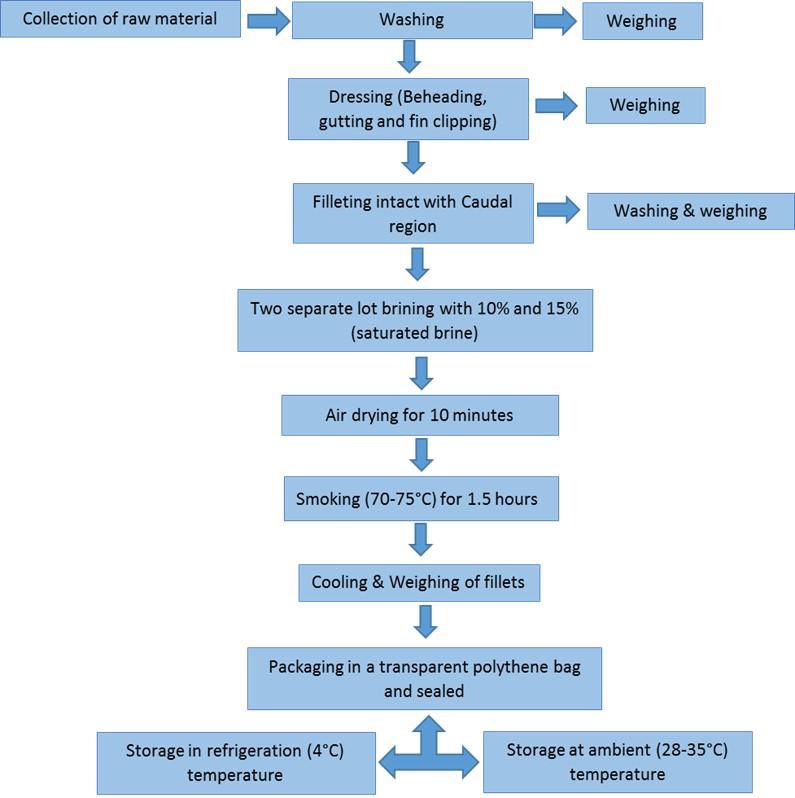
Collection of raw material
Pangasius catfish, which were used in the experiment, were purchased from wholesale market of Mymensingh and transported to the Fish Processing Laboratory of the Department of Fisheries Technology, Bangladesh Agricultural University for further treatment and smoke processing. A total of twenty fishes were randomly selected with an average weight 760±36g.
Salt treatment and smoking of fish
The fish were washed in potable water, weighed, and dressed. The beheaded fish were filleted from the neck to the tail with a sharp knife. The tail region of the fillets was left un-split. Sixteen fish were prepared for two different salt treatments: eight fish for 10% salt solution (T1), eight fish for 15% salt solution (T2), and four fish for untreated control. The fish were then air dried for about 10 min at room temperature.
For smoking of fish, an improved traditional smoking kiln was used [11]. Following air drying, the fillets of various treatments were hung from the iron rods inside the smoking kiln using metallic “S” shaped hooks. Throughout the smoking operation, a temperature of 70-75°C was maintained by using a thermometer and controlling the exit door. Smoking process was continued for about 1.5 h until the desired color and flavor was obtained. The smoked products were then allowed to cool at room temperature (30-35°C) for 15-20 minutes. Cooling facilitated to firm the muscle and prevented breaking of smoked fish fillets (Figure 2). The products were then placed in plastic bags, sealed with an electrical sealer machine, and labeled for further examination. For storage and analysis, the treated packaged fish were divided into two groups: one kept at ambient temperature (30-35°C) and the other kept at refrigeration temperature (4°C) to compare quality changes and shelf-life.
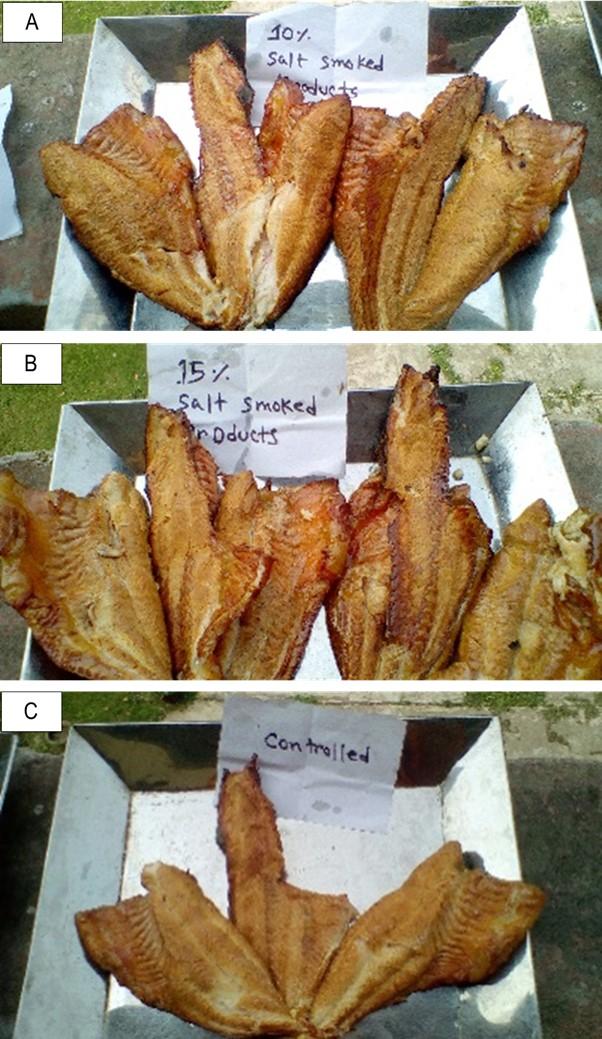
Quality assessment of smoked-cured products through sensory assessment
Sensory assessment was carried out using a 9-point hedonic scale [12] for evaluating the degree of freshness until it was considered rejected. For the samples stored at ambient temperature (30-35°C), sensory assessment was carried out every alternative day, while for samples stored at refrigeration temperature (4ºC), assessment was done at 7 days interval.
Analysis of proximate composition
Proximate analysis such as, determination of moisture, crude protein, crude lipid, and ash content of smoked products were carried out according to the methods described in AOAC, 2000 [13] with certain modifications. For proximate analysis, triplicate samples were used; the samples stored at ambient temperature were assessed on day 1, 3, 5, and 7 and those stored at refrigeration temperature (4°C), on day 1, 7, 14, 21, 28, 35, and 42. Moisture content was determined by using a thermostat oven (Gallenkamp, HOT-BOX, Manchester, UK), keeping the samples for 24 h at 105°C until a constant weight was obtained. For crude protein determination, total nitrogen content of the samples was determined by using a Micro-Kjeldahl method (Gallenkamp, Manchester, UK) after acid digestion. The amount of protein in the sample was calculated by multiplying the amount of nitrogen with 6.25, considering fish protein contains 16% nitrogen. Crude lipid content was determined by using a Soxhlet apparatus; acetone was used as an organic solvent; the extraction process was conducted at 70°C temperature for 3 hours. To determine the ash content, the organic matter of the sample was completely burnt off by a muffle furnace (Lab Heat Muffle Furnace, Blue M electric company, Blue Island, Illinois, USA) at a temperature of 550°C for 6 h.
Determination of salt (NaCl) content
The salt content (% NaCl) of smoked products was also determined following the methodology described in AOAC, 2000 [13].
Determination of TVB-N content
The TVB-N content (mg/100g) of the smoked products was determined by using the methods described in AOAC, 2000 [13].
Estimation of viable bacterial counts
Viable bacterial counts of the smoked-cured products were estimated in terms of colony forming unit CFU/g of samples following standard methods as described by Haider et al., 2021 [14]. Samples kept at ambient temperature (30-35°C) were analyzed on day 1, 5, and 9 and those kept at refrigerated temperature (4°C), on day 7, 14, 21, 28, and 35 during storage.
Statistical analysis
Data analyzed using MS Excel and one-way analysis of variance (ANOVA) (Duncan, 1993) and SPSS 25 (Chicago, USA) to detect significant differences among the treatments at 5% level.
RESULTS
The mean weight of whole fresh pangasius catfishes used for T1, T2 and control sample preparation was 766±26, 759±37 and 755±45 g, respectively, which after smoking showed reduced yields of 36.52±1.5, 37.92±2.3 and 36.13±2.1% respectively (Table 1). This reduction of weight of the products was due the higher temperature used in the smoking process for long period of time. The trends of weight reduction in three treatments confirmed the homogenous temperature reduction in the smoking kiln.
Table 1. Weight of whole fish, dressed fish, fish fillet of fresh fish and smoked fish, % yield of products after smoking procedure of pangasius catfish of three different treatments T1, T2, and control samples, respectively.
Changes in sensory quality attributes of different salt-smoked cured products at different temperatures
The sensory quality of the smoked fish products was evaluated on day 1, 3, 5, 7, and 9 for those stored at ambient temperature (30-35°C) (Table 2) and on day 1, 7, 14, 21, 28, 35, and 42 in case of the samples sored at refrigeration temperature (4°C) (Table 3). Sensory characteristics including color, flavor, texture, taste, general appearance, and overall mean acceptability of the products were judged. The parameters like color, flavor, texture, taste, and general acceptability of the products were found better at the beginning of storage based on the grading scale.
At initial stage, smoked product T2 had the highest mean acceptability score 8.84 based on 9-point hedonic scale, which was better than T1 and control samples (Table 2). It was found that in ambient temperature smoked products of T1 has mean acceptability score 2.7 on day 7 of observation whereas T2 was found good on the same day. The control samples deteriorated on day 5 of storage due to slight fungus was revealed on its surface. With the time of storage, the quality also degraded and mean acceptability became poor.
Table 3 presented that T1 had mean acceptability score 2.76 on day 35 of storage whereas T2 found better (3.68) on the same day. The control samples were found unacceptable due to fade brownish color, slightly off flavor odor, softening texture, slightly unpleasant taste thus was considered for rejection on day 28 which confirmed T2 had better shelf-life in refrigerated stored product.
Table 2. Means acceptability scores for sensory evaluation of T1, T2, and control samples of smoked pangasius catfish on different days of storage at ambient temperature.
Table 3. Means acceptability scores for sensory evaluation of T1, T2, and control samples of smoked pangasius catfish on different days of storage at refrigerated temperature.
Effect of temperatures on proximate composition in salt-smoked cured products
Proximate composition analysis of moisture, crude protein, lipid and ash were carried out of fresh pangasius catfish are shown in (Table 4). The proximate composition of the T1, T2, and control samples at different storage condition were analyzed. In case of ambient storage (30-35°C) analysis was carried out on day 1, 3, 5, and 7 for different samples. While, in the case of the samples stored at refrigerated temperature, analyses were performed on day 1, 7, 14, 21, 28, and 35 of storage.
The mean moisture, protein, lipid, and ash content were found 76.80±0.13, 13.60±0.26, and 7.79±0.03 and 1.41±0.03%, respectively and the values which reduced in all products prepared for different treatments after smoking (Table 4). The overall proximate composition values in all treated products were reduced due to heat treatments (75°C) used in smoking. Deposition smoke particles on the product surface had given attractive and characteristic color of smoked-cured products.
The initial mean moisture content of fresh pangasius catfish was 76.80% (Table 4). The changes in moisture content of smoked fish tissues of different treatments are shown in both storage conditions presented in Table 5 and Table 6 where hot smoke treatment reduced the moisture of fish flesh content from 76.80% to 68.80, 67.19 and 70.79% in T1, T2 and control samples, respectively. The moisture content found significantly differences among all three treatment (p˂0.05) (Table 5 and Table 6). The moisture changes in refrigerated storage products also vary slowly. On 35 days of observation, the moisture content was 67.82±0.37% in T2, which was lower than other two types (T1 and control).
The mean protein content of fresh pangasius catfish was 13.60%. After smoking protein content increased to 19.45, 20.20 and 18.48% in T1, T2 and control samples, respectively due to decrease in moisture content from fish flesh (Table 1). The protein content found significantly differences among all three treatments (p˂0.05) (Table 5 and Table 6).
Similarly, in refrigerated condition significant differences in protein content found among all three treatments. On day 35, the protein content of T2 sample was 20.45±0.52%, while initial protein content of this same treatment was 20.20±0.61% on the day 1 (Table 6).
The mean initial lipid content of fresh pangasius catfish was 7.79%. After smoking lipid content slightly increased in different treatment of fish products as 10.28%, 11.40% and 9.52% in T1, T2 and control samples, respectively (Table 4). There was found significance difference (p˂0.05) in lipid content among all three treatments of both two storage conditions (Table 5 and Table 6). On the day 35, T2 sample had lipid content 11.01±0.49% where no remarkable changes were observed during storage period.
The initial mean ash content of fresh pangasius catfish was 1.41% and after smoking ash content increased to 1.55, 1.58 and 1.48 in T1, T2 and control samples, respectively (Table 5 and Table 6). However, there is no significant differences of ash content among three treatments were found at different days in the products stored at ambient and refrigeration temperatures (p˂0.05) (Table 5 and Table 6). The ash content increased after smoking because salt intake during processing fish samples.
Table 4. Proximate composition (moisture, protein, lipid, and ash content) of fresh pangasius catfish used for smoking and three different types of smoked products.
Table 5. Changes in proximate composition (moisture, protein, lipid, and ash content) of different smoked products on different days of storage at ambient temperature.
Table 6. Changes in proximate composition (moisture, protein, lipid, and ash content) of different smoked products on different days of storage at refrigeration temperature.
Comparison in salt contents of different salt-treated smoked cured products
The changes in salt content of smoked pangasius catfish tissues of T1 and T2 during ambient and refrigeration storage period are presented in Figure 3 and Figure 4. The salt concentrations were 3.65(±0.03) % in T1 and 4.87(±0.04) % in T2 just after smoking (on the day 1). The salt concentrations become 3.69(±0.08) % for the T1 samples and 4.91(±0.06) % for the T2 samples on day 7 of storage at ambient temperature (Figure 3). On the contrary, samples kept at refrigerated storage had salt contents of 3.70(±0.13) % and 4.99(±0.16) % in T1 and T2 samples, respectively on day 35 of observation (Figure 4).
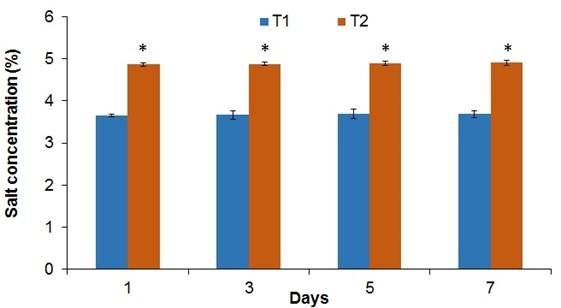
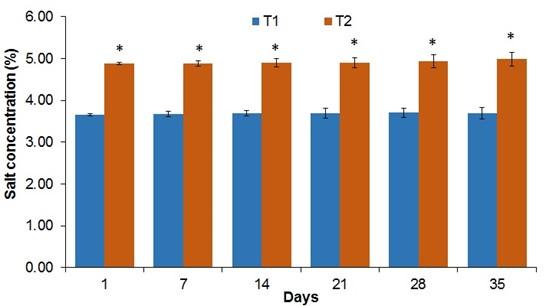
Effect of temperatures on TVB-N contents in different salt-smoked cured products
The changes in TVB-N content of smoked pangasius catfish tissues of the three different types of products during both storage temperatures are presented in Figure 5 and Figure 6, showing that an increasing pattern with time elapsed in all treatments. TVB-N values were 4.82(±0.02) mg/100g, 4.48(±0.08) mg/100g, and 5.52(±0.53) mg/100g of the T1, T2 and control samples, respectively on day 1 after smoking. The samples kept ambient temperature were showed relatively higher level of TVB-N values within shorter period of time. In room temperature, the control samples had the average highest value of TVB-N, 42.89(±1.89) mg/100g, on day 5 and rejected. The T1 samples had the average highest value of TBV-N on day 7, which was 40.34(±1.35) mg/100g; while the T2 samples had the average highest value on the day 9, about 43.00(±2.99) mg/100g, and both were rejected (Figure 5). In case of refrigerated storage condition, TVB-N values were also gradually increased with time. The highest average TVB-N contents were followed up to day 21, 28, and 35 for the samples of control, T1, and T2, respectively. On the day 21, the average TVB-N value for the control samples was 32.8(±2.55) mg/100g. In case of the T1 samples on the 28, the average TVB-N value was 31.24(±1.15) mg/100g; while for T2 samples on day 35 of observation, the average TVB-N value was 28.33(±2.45) mg/100g (Figure 6).
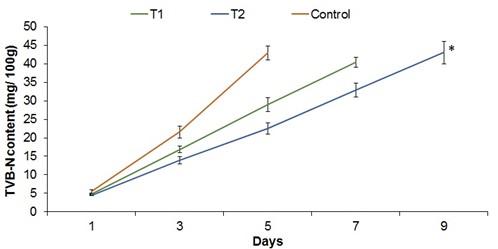
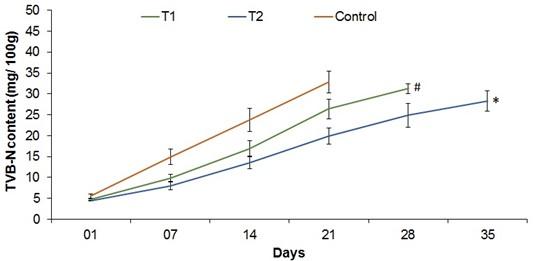
Figure 6. Changing pattern of TVB-N values (mg/100g) of different smoked-cured products from pangasius catfish on different days of storage at refrigerated temperature (4°C); the error bars indicating standard deviations, a hash mark and an asterisk indicating significant differences (p<0.05) between the control and T1, and between the control and T2, respectively.
Effect of temperatures on fluctuation in viable bacterial counts in different salt-smoked cured products
The viable bacterial count in fresh pangasius catfish fillets was 1.67×105 CFU/g (Table 7) where, the smoked fillets in T1, T2, and control samples on day 1 were 3.26×104, 1.39×104 CFU/g and 4.92×104 (Table 7). On day 9, T1 and T2 had 2.67×107 and 4.88×106 CFU/g. Viable bacterial count of T1, T2 and control samples was found to be increased gradually with the lapse of time and reached maximum at unacceptable limit and then it was considered as spoiled. On the other hand, viable bacterial count was analyzed up to day 35 for T2 samples, which reached 5.92×107 CFU/g (Table 8).
Table 7. Viable bacterial counts (CFU/g) of fresh pangasius catfish and changes of viable bacterial counts (CFU/g) of different smoked products on different days of storage at ambient temperature.
Table 8. Changes of viable bacterial counts (CFU/g) of different smoked products on different days of storage at refrigerated temperature.
DISCUSSION
The study was conducted to prepare smoked cured products from pangasius catfish and to evaluate their quality and shelf-life under ambient (30-35°C) and refrigeration (4°C) temperature. The products were salt treated for 15 minutes in 10% (T1) and in 15% salt (T2). One group was kept as control, without any salt treatment.
The smoking effects reduce the rate of spoilage. However, for longer shelf-life the smoked-cured products may be kept at refrigeration temperature for better shelf-life [11]. Previous studies also reported that shelf-life of smoked pangasius catfish was higher with comparatively higher salt treatment (26%) stored in both ambient and refrigerated storage conditions [15]. Similar study on the shelf-life of the smoked Ribbon fish (Trichiurus haumela), reported shorter shelf-life of 4 and 6 days at ambient temperature (30-35°C) for control smoked (smoked without salt) and 25% salt treated smoked product, respectively [16]. However, temperature used during smoking has great effect on the shelf-life of the smoked-cured products. In case of tilapia (Oreochromis niloticus), smoking conducted at 60°C and at 80°C had better shelf-life of 30 days and 45 days, respectively [7]. The results are more or less similar to our studies; smoked products stored at refrigeration temperature showed greater shelf-life of up to 35 and 42 days for the T1 (10% salt treated) and T2 (15% salt treated), respectively.
The moisture content of the smoked fish products was varied 11.7-69.2% depending on the fish species and smoking methods [17]. The moisture content of pangasius catfish fillet was 71.07% which, decreased to 66.18-67.81% after smoking, and varied with storage conditions [11]. Similar moisture content was reported for fresh pangasius (72.82% moisture) but reduced to 67.05% on the day 45 of storage [15]. Moisture content of fresh tilapia was reported 78.82% that decreased to 67.55-72.05% after smoking at different storage conditions [7].
During the smoking process, a significant amount of moisture is evaporated, and salt is penetrated thus, their content becomes higher [11]. The protein content of the smoked-cured pangasius catfish was reported similar to our studies. In the saturated brine dipped and medium hot smoked pangasius catfish, the protein content was 20.18% on the day 1 and 20.45% on the day 21 of observation [18]. Protein content of fresh pangasius fish fillet was 16.58% whereas after smoking, the protein content increased to 20.50%, 21.07% and 21.20% in three different treatments (10% salt, 25% salt, and 25% salt plus spice) [19].
Lipid content was reported to range from 9.00-14.50% in six smoked fishes [20]. In case of pangasius catfish, medium hot smoked products had lipid content of 13.26% on the day 1 and 13.32% on the day 21 of observation [18]. Similarly, fresh pangasius catfish had initial lipid content of 8.88 % and the value became 10.34% after smoking on day 45 day of storage [15].
In pangasius catfish smoked at medium temperature (50°C), the ash content ranged from 1.3 to 1.60% in different days of observation [18]. The initial ash in pangasius catfish fish fillet was 1.25%, which after smoking become 1.43%, 1.45%, and 1.50% in three different treatments [19].
Due to salt treatment and smoking effects (evaporation of moisture), the salt content is usually increased in the salt treated smoked products. Previous reports showed that pangasius catfish fish had salt content ranging between 2.22% and 2.89% on different days of observation at refrigeration storage condition [18]. The salt content values of smoked product ranging from 4.81-6.91% during different storage condition of different treatments [11]. Similarly, salt content of pangasius catfish fillet after smoking was 5.37% in treatment ‘A’ and 6.80% in treatment ‘B’ which immersed on 26% salt solution before smoking. Increased salt content 5.38% and 6.91% was found in A and B respectively observed on different storage conditions from day 1 to day 60 of observation [7].
The TVB-N content indicates the degree of spoilage of fish and fishery products. In a previous study, initial TVB-N values after smoking was 4.52 mg/100g and 5.31 mg/100g in two different treatments [11]. The TVB-N content was found to increase up to 30.95-32.05 mg/100g on the day 35 of observation in refrigerated condition [15]. Another study showed that medium hot smoked pangasius catfish products had TVB-N (mg/100g) values ranged from 6.04-18.12mg/100g on the 21 days of observation in refrigerator storage condition [18].
During salt treatment and smoking, the viable count was found to decrease compared to the fresh fillets. The effects of salt penetration, high temperature during smoking, evaporation of moisture and accumulation of inhibitory smoke particles has a negative effect on bacterial growth and activities. However, during storage the viable bacterial counts increased again especially in those stored at ambient room temperature. Similar tendencies were observed in the smoked-cured pangasius catfish products in our study. In a previous study, the viable bacterial counts of fresh pangasius catfish were 1.56×105 CFU/g which become about 2.92×108 CFU/g on the day 21 of storage at refrigeration temperature (4°C) [3]. In another study, initial bacterial load of fresh pangasius catfish fillet was 1.5×104 CFU/g, which slightly decreased after smoking but become 3.5×107 CFU/g on the day 5 of storage [15]. Similar types of results were also reported in case of other fish species. For example, bacterial count in fresh spotted snakehead (C. panctatus) was 1.55×106 CFU/g, which become 4.3×104 CFU/g and 3.13×103 CFU/g in the untreated and 20% salt treated samples, respectively after smoking (before storage) [6] as salt has an inhibitory effect on bacterial growth [21]. A similar observation was reported in the case of smoked products from tilapia fish (O. niloticus). The viable bacterial counts at refrigeration temperature (4°C) were reported to 3.98×104 CFU/g and 5.10×106 CFU/g for two different salt dipped samples on day 45 of observation [7]. Considering the viable bacterial counts of the smoked-cured products, the degree of spoilage is determined; viable bacterial counts more than 108 CFU/g is considered spoiled and rejected [22].
CONCLUSION
Considering the result of sensory evaluation, proximate composition, TBV-N contents, salt contents, and viable bacterial counts it was found that the smoked fish products of T2 (15% salt treated) was better in quality with longer shelf-life compared to the products of control (no salt treatment) and T1 (10% salt treated) in this study. Consumers’ preferences to ready-to-eat and value-added new fish products are increasing day by day. Thus, development of salt-treated smoked-cured pangasius catfish products will be preferred due to their good taste, less bones, and relatively higher shelf-life. Moreover, it will increase the utilization of this low-priced fish widely and enhance the profitability of the fish farmers.
ACKNOWLEDGEMENTS
The authors are grateful to the Department of Fisheries Technology, Bangladesh Agricultural University, for the laboratory and technical supports. Sincere acknowledge to the Bangladesh Agricultural University Research System (BAURES); and to the Ministry of Science and Technology (MoST), Government of Bangladesh, for the research grants (fellowship- 238, 2019-2020).
AUTHOR CONTRIBUTIONS
The work was designed and supervised by SCC and MNH. The research work and data analyses were performed by SKS. The first draft of this manuscript was prepared by SKS, SCC improved the manuscript. MNH critically revised figures and tables, improved and approved the final version of the manuscript.
CONFLICTS OF INTEREST
There is no conflict of interest among the authors.
References
- [1]Nwaigwe U. Fish preservation and processing. CYTA J Food. 2017; 2(1): 1–31.
- [2]Nahid MN, Latifa GA, Chakraborty SC, Farid FB, Begum M. Shelf-life quality of smoke- dried freshwater SIS fish; chapila (Gudusia chapra, Hamilton-Buchanan); kakila (Xenentodon cancila, Hamilton-Buchanan; 1822) stored at laboratory condition (26-31°C). J Agri and Vet Sci. 2016; 9:23-32.
- [3]Salim GM, Islam MN, Chakraborty SC. Shelf-life and bacteriology of smoked fish prepared from Pangasius catfish (Pangusius hypophthalmus). Progressive Agriculture. 2007; 18(1): 199-207.
- [4]DoF. Yearbook of Fisheries Statistics of Bangladesh, 2020-21. Fisheries Resources Survey System (FRSS), Department of Fisheries, Bangladesh. Ministry of Fisheries and Livestock. 2022; 38: 92.
- [5]Rana MM. Study on acceptability and shelf-life of salt-smoke-dried fish product prepared from tengra (Mystus tengera), batasi (Neotropius atherinoides) kept at different storage condition. M S thesis. Department of Fisheries Technology, Bangladesh agricultural University, Mymensingh. 2016; 126.
- [6]Bormon A, Chakraborty SC, Mansur MA, Jahan MP. Comparative study of quality aspects and shelf-life of salted and unsalted smoked products from spotted snakehead (Channa punctatus) at various storage conditions. Research in Agriculture Livestock and Fisheries. 2020; 7 (2): 303-310.
- [7]Das R, Chakraborty SC, Rayhan A. Comparative Shelf-life quality analysis of smoked tilapia using two different temperatures. International Journal of Applied Research. 2017; 3(2): 35-41.
- [8]Espe M, Nortvedt R, Lie O, Hafsteinsson H. Atlantic salmon (Salmo salar), as raw material for smoking industry. 1: effect of different salting methods on the oxidation of lipids. Food Chem. 2001; 75 (4): 411-416.
- [9]Jittinandana S, Kenney PB, Slider SD, Kser RA. Effect of brining concentration and brining time on quality of smoked rainbow trout fillets. J Food Sci. 2002; 67 (6): 2095-2059.
- [10]Dutta M, Majumdar PR, Islam RU, Saha D. Bacterial and Fungal Population Assessment in Smoked Fish during Storage Period. J Food Microbiol Saf Hyg. 2018; 3: 127.
- [11]Debnath SK, Chakraborty SC, Sharmin R, Nath PCD. A study on the improved technique for the production of smoked Pangasius catfish (Pangasius hypophthalamus). Int J Biores. 2009; 2(12):74-50.
- [12]Larmond E. Laboratory methods for sensory evaluation of food. Research Branch, Canada Dept of Agriculture Publication.1977; 1637.
- [13]AOAC. Official method of analysis. Association of Official Agricultural Chemists’. Horwitz Editor), 12th ed, Washington DC. 2000.
- [14]Haider MN, Bhattacharjee S, Shikha FH, Hossain MI. Bacterial Count and Proximate Composition of an Indian sub-continental Freshwater Barb, Punti (Puntius sophore ) and a Gangetic Catfish, Gulsha ( Mystus cavasius ) during Drying-up Process. J Aquat Food Prod. 2021; 30 (4): 474-483.
- [15]Rayhan A, Chakraborty SC, Das R. Effect of temperature on the quality of smoked Pangasius catfish (Pangasius hypopthalamus). Int J Nat Soc Sci. 2017; 4(2): 46-53.
- [16]Chowdhury IA. Development of quality smoked product from ribbon fish (Trichiurus haumela) for its acceptability and shelf-life study during different storage condition, MS thesis. Bangladesh Agricultural University, Mymensingh, Bangladesh. 2017.
- [17]Nketsia T, Sefa-Dedeh S. Quality attributes of cured fish in Ghana. J Appl Sci Technol. 2000; 5 (1&2): 148-155.
- [18]Gopal S. A study on the shelf-life of smoked Pangasius catfish (Pangasius hypophthalmus). MS thesis, Department of Fisheries Technology, Bangladesh Agricultural University, Mymensingh. 2005; 71.
- [19]Mohsin A. Study of hot smoke curing of Pangasius catfish (Pangasius hypophthalamus) at different condition. MS thesis. Bangladesh Agricultural University, Mymensingh, Bangladesh. 2008.
- [20]Kosygin L, Lilabati H, Viswanath W. Proximate composition of commercially important hill stream fishes of Monipur. India J of Fisheries. 2001; 48(1):111-114.
- [21]Nowsad AKMA. Participatory Training of Trainers: A new approach applied in fish processing. Bengal Com-print, 68/5, Green Road, Dhaka, Bangladesh. 2007; 171.
- [22]Ojagh SM, Rezaei M, Razavi SH, Hossein SMH. Effect of chitosan coatings enriched with cinnamon oil on the quality of refrigerated rainbow trout. Food Chem. 2010; 120(1): 193-198.